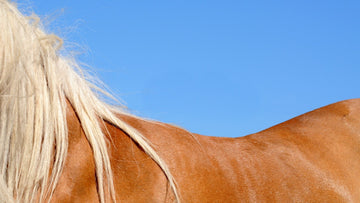Horses’ backs quite literally bridge the gap between majestic necks, powerful legs, and swishing tails. Other than asking for lifts and bends throughout training, back conditioning and health can be out of sight and mind.
Unsoundness in legs and feet is often front and center, being diagnosed and treated, while stiffness and pain in horses’ backs can lurk in the background for years.
 A horses’ back isn’t finished developing until six years of age. Most horses undergo intense training after they are two-years-old, and most disciplines have horses under saddle before they are six.
A horses’ back isn’t finished developing until six years of age. Most horses undergo intense training after they are two-years-old, and most disciplines have horses under saddle before they are six.
Spinal Fortress
A horses’ back is a complex system of muscles, bones, cartilage, ligaments, and nerves working together to safely relay signals from the brain through the spinal cord to the body. Damaged parts in this system can cause a domino effect of stiffness and injury.
If you’ve ever experienced back pain, it can be easy to see how even a tight muscle can make every move difficult.
In an interview with Equus Magazine, Jenny Johnson, VMD, of Oakhill Shockwave and Veterinary Chiropractic in Calabasas, California explained that each discipline requires a horse to push from behind. A dressage horse needs power from its’ back end to hold itself in an elegant piaffe, while a reining horse pushes from behind as it powers down the arena for a sliding stop.
Backs are important, but a lack of awareness can leave our equine friends aching without us realizing it. Proper maintenance such as thorough warm-up and cool-down routines, stretches, massages, chiropractic work, and therapeutic wearables such as BeneFab’s Rejuvenate Smartscrim can set a horse up for success.
Signs of Pain
Some signs of back pain are unmistakable, and others are only noticeable under saddle or by observant caretakers.
Unwillingness to Lower Head and Graze
This intense symptom can be caused by a horse falling over backward and fracturing the vertebrae that make up the withers. Wither fracture recovery is possible, but veterinary supervision and diligent care are needed.
Grumpy When Saddled
This symptom is tough because the cause can range from back pain to ulcers. Taking ‘girthiness’ seriously and observing for any abnormal movement after saddling is essential.
Discomfort When Touched on Back
Horses who are in great discomfort or are very expressive may show signs of pain with even a brush on their backs. This symptom shouldn’t be mistaken as a bad attitude. X-rays and veterinary evaluation can help rule out back pain and make sure your equine friend is feeling okay.
Changes Under Saddle
Horses with a sore back will often change their movement under saddle to protect themselves. An extension of the trot may pull on the longissimus muscle too much, and jumping fences may see the saddle put pressure on sensitive withers. Watching for more tail swishing and hesitation to perform may indicate something is awry.
Difficulty Standing for Shoeing
Shoeing often sees horses’ feet propped up and held in ways they don’t experience every day. Taking time to observe their reaction to being shod can give a caretaker a heads up on any discomfort.
Dealing with back pain in horses can be a challenging road. Working with your veterinarian can get your horse the diagnosis and help he needs to perform at his best.






















